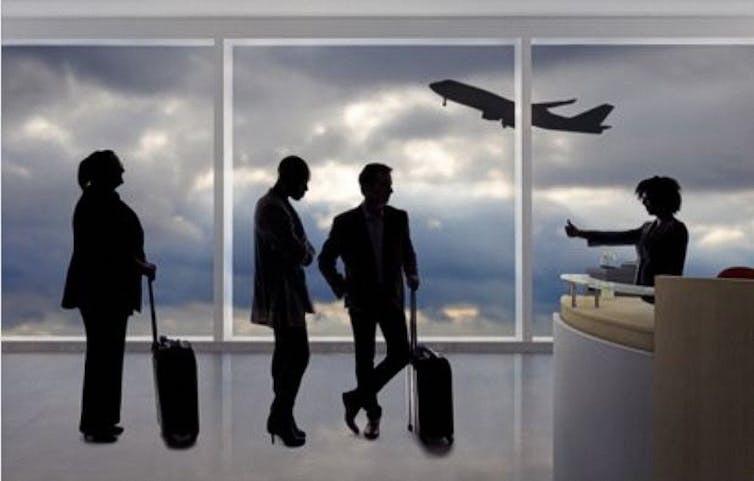New ways of 'being together apart' can work for us and the planet long after coronavirus crisis passes
- Written by Andrew Glover, Postdoctoral Research Fellow, RMIT University
Most major corporate, academic and other networking events have been cancelled because of the risks of spreading the coronavirus while travelling or at the events themselves. This flurry of cancellations has even spawned a literally titled website: https://www.isitcanceledyet.com/. But the changes in behaviour now being forced upon us might benefit the planet in the long term as we find and get used to other ways of holding meetings.
The COVID-19 pandemic is driving the development of these alternatives to physical travel and meetings much more strongly than climate change had to date. With many countries closing their borders, limiting domestic travel and imposing restrictions on large gatherings, few conferences are likely to proceed in the coming months of 2020.
Read more: How changes brought on by coronavirus could help tackle climate change
Old conference model is unsustainable
Traditional face-to-face conferences tend to be rather unsustainable affairs. Participants often fly from around the world to attend – usually accompanied by some carbon-intensive conference tourism along the way. For people who take just one long-haul flight per year, air travel is likely to be the single largest contributor to their carbon footprint.
 If you make a long-haul flight to attend a meeting once a year that’s enough to greatly increase your carbon footprint.
Rommel Canlas/Shutterstock
If you make a long-haul flight to attend a meeting once a year that’s enough to greatly increase your carbon footprint.
Rommel Canlas/Shutterstock
The dramatic decline in conferences and other meetings is likely to contribute to a significant drop in carbon emissions from air travel in 2020.
Conferences and meetings have come to be regarded as important parts of professional life. They allow us to connect with people and ideas in our field, and can be opportunities to advance new knowledge.
But with so many of us effectively “grounded”, what are the alternatives to attending traditional conferences and meetings?
Digital conferencing on the rise
The use of digital conferencing platforms has skyrocketed in the past few weeks as more and more people work from home and travel is restricted.
Leading US Democratic presidential candidate Joe Biden even held a “virtual town hall” meeting recently as part of his campaign, although many users reported technical glitches and low-quality video plagued the experience.
Conferences are even taking place in virtual reality settings. These dedicated online conferencing environments are designed to mimic the venues conferences are often held in. These online events have large auditoriums, smaller “breakout rooms” and even socialising spaces to meet other participants through the use of digital avatars.
However, online conferencing need not be held in immersive 3D environments to be successful.
Exploring alternative formats
Most traditional conferences tend to be quite similar in format. They’re usually in a fixed location and run for two to five days. Presenters speak in front of live audiences on a fixed schedule.
Some digital conferences try to mimic this format, but others are trying to use the technology to open up the possibility for new types of event formats.
The “nearly carbon-neutral” conference model was initially developed to reduce the emissions associated with flying to conferences. Presentations are broadcast online over about two weeks. Participants can interact with presentations via accompanying text channels. The lectures and text messages are preserved online, creating an accessible archive.
Some events are being broadcast on the website Twitch. It’s a popular streaming platform where online gamers broadcast to – and interact with – surprisingly large audiences. This shows how conference organisers planning online events may need to look to communities who have been connecting and interacting “at a distance” long before any travel bans came into force.
 The gaming community has led the way in developing mass meetings online.
Facebook
The gaming community has led the way in developing mass meetings online.
Facebook
Do we even need video?
It’s common for conferences and other events to have Twitter “backchannels” where participants post short messages about their experiences of attending the event to a dedicated hashtag. People who are unable to attend can view these messages to get a sense of “being there”.
The “Twitter conference” has taken this a step further. The digital event just involves participants posting on a dedicated hashtag at a set point in time.
Events like this show conferences can be stripped down to what they are ultimately about: connecting with people and ideas that we’re interested in.
One size won’t fit all
It’s unlikely any one event format will suit every purpose. Organisers will need to be creative in how they schedule and plan events. They’ll have to consider what they want to accomplish and what types of participation they want to have.
Digital conferencing may even give less mobile groups – people with disabilities or caring responsibilities or who are averse to flying – an opportunity to attend events they might have been unable to take part in before.
Ultimately, the restrictions on air travel and social gatherings will force us to adapt to new ways of “being together apart”, both professionally and personally. We may not be able to share a conference space with our peers and collaborators, but we can still connect with them. We might even learn more about what type of travel is really necessary, with the invaluable benefit of reducing the pace of climate change.
Authors: Andrew Glover, Postdoctoral Research Fellow, RMIT University



















